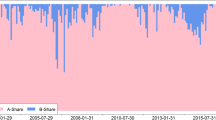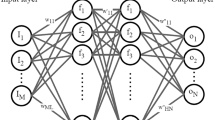Abstract
A major inconvenience of the traditional approach in portfolio choice, based upon historical information, is its inability to anticipate sudden changes of price tendencies. Introducing information about future behavior of the assets fundamentals may help to make more appropriate choices. However, the specification and parameterization of a model linking this exogenous information to the asset prices is not straightforward. Classification trees can be used to construct partitions of assets of forecasted similar behavior. We analyze the performance of this approach and apply it to different sectors of the S&P 500.
Similar content being viewed by others
References
Albanis G, Batchelor R (2000) Five classification algorithms to predict high performance stocks. In: Dunis C (ed) Advances in quantitative asset management. Kluwer Academic Publishers, Boston, pp 295–318
Arentze T, Timmermans H (2003) Measuring the goodness-of-fit of decision-tree models of discrete and continuous activity-travel choice: methods and empirical illustration. J Geograph Syst 5:185–206
Basu S (1977) Investment performance of common stocks in relation to their price-earnings ratios: a test of the efficient market hypothesis. J Finance 32(3):663–682
Bollerslev T, Engle R, Wooldridge J (1988) A capital asset pricing model with time-varying covariances. J Polit Econ 96(1):116–131
Breiman L (1996) Bagging predictors. Mach Learn 24(2):123–140
Breiman L, Friedman J, Olshen R, Stone C (1984) Classification and regression trees. Wadsworth, Belmont California
Capual C, Rowley I, Sharpe WF (1993) International value and growth stock returns. Financ Anal J 49(1): 27–36
Chan LKC, Jegadeesh N, Lakonishok J (1996) Momentum strategies. J Finance 51(5):1681–1713
De Bondt W, Thaler R (1985) Does the stocks market overreact?. J Finance 40(3):1681–1713
De Bondt W, Thaler R (1987) Further evidence on investor overreaction and stock market seasonality. J Finance 42(3):557–581
Fama E, French K (1992) The cross-section of expected stock returns. J Finance 47(2):427–465
George TJ, Hwang C-Y (2004) The 52-week high and momentum investing. J Finance 59(5)
Han J, Kamber M (2001) Data mining: concepts and techniques. Morgan Kaufmann, San Francisco
Hastie T, Tibshirani R, Friedman J (2001) Elements of statistical learning: data mining, inference, and prediction. Springer, New York
Hosmer DWJ, Lemeshow S (2000) Applied logistic regression (Wiley series in probability and statistics - applied probability and statistics section), 2nd edn. Wiley–Interscience, New york
Jegadeesh N (1990) Evidence of predictable behavior of securities returns. J Finance 45(3):881–898
Jegadeesh N, Titman S (2001) Profitability of momentum strategies: an evaluation of alternative explanations. J Finance 56(2):699–720
Kao D, Shumaker R (1999) Equity style timing. Financ Anal J 55:37–48
Lehmann BN (1990) Fads martingales and market efficiency. Q J Econ 105(1):1–28
Lo AW, Mamaysky H, Wang J (2000) Foundations of technical analysis: computational algorithms, statistical inference, and empirical implementation. J Finance 55(4):1705–1770
Martinez WL, Martinez AR (2002) Computational statistics handbook with MATLAB. Chapman and Hall/CRC, London
Ritschard G, Zighed DA (2003) Goodness-of-fit measures for induction trees. In: Foundations of intelligent systems, 14th international symposium, ISMIS 2003, Maebashi City, Japan, October 28–31, 2003, Proceedings, pp 57–64, Springer, Heidelberg
Sorensen E, Miller K, Ooi C (2000) The decision tree approach to stock selection. J Portfolio Manage 42–52
Sutton CD (2005) Classification and regression trees, bagging and boosting. In: Rao C, Wegman E, Solka J (eds) Handbook of statistics: data mining and data visualization, vol 24. Elsevier, North Holland
Velikova M, Daniels H (2004) Decision trees for monotone price models. Comput Manage Sci 1(3):231–244
Author information
Authors and Affiliations
Corresponding author
Rights and permissions
About this article
Cite this article
Roko, I., Gilli, M. Using economic and financial information for stock selection. Comput Manage Sci 5, 317–335 (2008). https://doi.org/10.1007/s10287-007-0056-x
Published:
Issue Date:
DOI: https://doi.org/10.1007/s10287-007-0056-x




